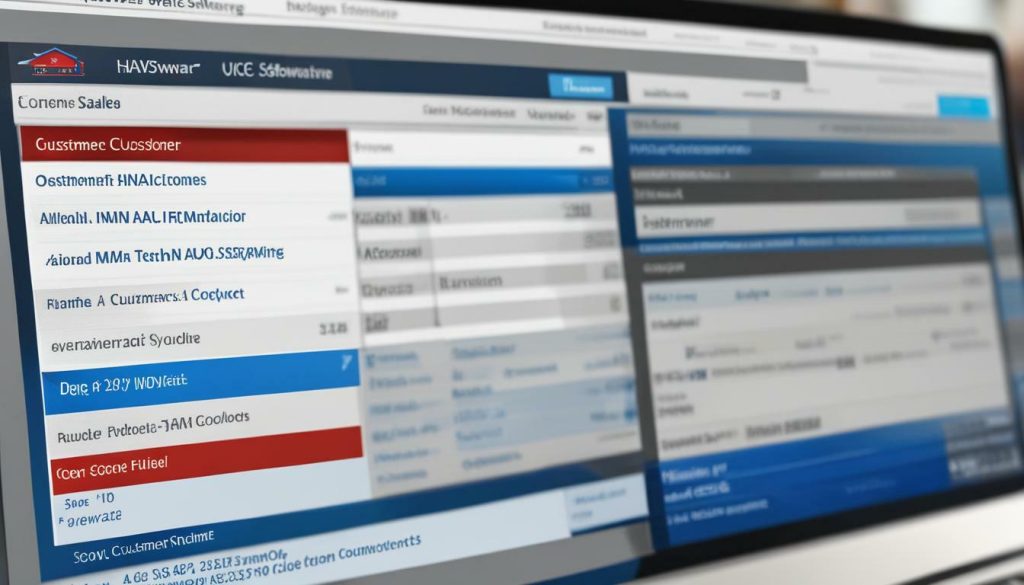Implementing new HVAC sales software can significantly enhance the performance of your HVAC company, but it requires careful planning and execution. By streamlining your sales process and leveraging the right tools, you can improve productivity, efficiency, and sales opportunities.
Key Takeaways:
- Assess the skills of your sales team to match technicians with the right sales calls.
- Utilize HVAC software tools like ServiceTitan to streamline the dispatching process and improve efficiency.
- Prepare technicians for sales calls by reviewing customer information and establishing rapport with homeowners.
- Follow a structured sales call framework to ensure consistency and effectively communicate value.
- Conduct comfort surveys to understand customer needs and pain points.
By following these steps and best practices, you can successfully implement new HVAC sales software and drive growth for your business.
Assessing Your Sales Team’s Skills
The success of implementing new sales software relies on understanding your sales team’s abilities and assigning them to appropriate sales calls. Before implementing the software, it’s crucial to assess the skills and strengths of your sales team. This assessment will help you identify the best technicians for each sales call, ensuring optimal customer interaction and increased chances of sales success.
One way to assess your sales team is by implementing a rating system that evaluates their performance and capabilities. By evaluating factors such as communication skills, product knowledge, and sales techniques, you can better match technicians to the right jobs. Assigning technicians with strong sales skills to high-value sales calls will significantly increase your chances of closing deals and maximizing revenue.
Furthermore, effective delegation of jobs to technicians is essential in implementing sales software successfully. By understanding each technician’s strengths and weaknesses, you can assign them to sales calls that align with their skills. This targeted approach ensures that your team can make the most of the new sales software, utilizing its features and functionalities to drive sales growth.

Assessing Sales Skills Rating System
| Rating Scale | Skill Level |
|---|---|
| 5 | Exceptional |
| 4 | Above Average |
| 3 | Average |
| 2 | Below Average |
| 1 | Needs Improvement |
In conclusion, assessing your sales team’s skills and assigning them to appropriate sales calls is a crucial step in successfully implementing new HVAC sales software. By utilizing a skills rating system and effectively delegating jobs to technicians, you can optimize customer interactions, improve sales performance, and maximize the benefits of the software.
Streamlining Dispatching with HVAC Software Tools
Simplify your dispatching process and overcome challenges by leveraging HVAC software tools during the implementation phase. Implementing new HVAC sales software requires a well-defined sales process and effective delegation of jobs to technicians. Prioritizing high-value sales calls and assigning technicians with strong sales skills to those calls is essential for success. To streamline the dispatching process and improve efficiency, HVAC contractors can utilize HVAC software tools like ServiceTitan.
These software tools provide a centralized platform for managing and scheduling appointments, tracking technician availability, and optimizing route planning. With features such as real-time GPS tracking and automated notifications, contractors can ensure that technicians reach their destinations on time and provide timely service to customers.
Additionally, HVAC software tools facilitate seamless communication between the office and field technicians, allowing for instant updates on work orders, repair status, and customer information. This eliminates the need for manual paperwork and reduces the risk of miscommunication or errors. By centralizing information and streamlining the dispatching process, contractors can enhance their overall operational efficiency and deliver exceptional customer service.
Benefits of Streamlining Dispatching with HVAC Software Tools
- Efficient appointment scheduling and route optimization
- Real-time GPS tracking and notifications for improved timeliness
- Instant updates on work orders and repair status
- Streamlined communication between office and field technicians
- Enhanced operational efficiency and customer service
- Reduced paperwork and risk of errors
- Centralized platform for managing customer information
By leveraging HVAC software tools during the implementation phase, HVAC contractors can simplify their dispatching process and overcome challenges. These tools streamline communication, optimize scheduling, and enhance overall operational efficiency, leading to improved customer satisfaction and business performance.

Preparing Technicians for Sales Calls
Equipping your technicians with the necessary information and skills is crucial for successful sales calls. When implementing new HVAC sales software, it’s important to prioritize the preparation of your technicians to maximize their effectiveness during sales interactions. By reviewing relevant information about the customer’s history, previous work done, and any outstanding estimates, your technicians can provide personalized service and address specific needs.
Establishing a rapport with the homeowner is also essential in building trust and enhancing the sales process. Encourage your technicians to use icebreakers and show professionalism to create a positive first impression. By demonstrating expertise and actively listening to the homeowner’s concerns, your technicians can establish credibility and increase the chances of a successful sale.
During the sales call, it’s important to follow a structured framework. This includes conducting a comfort survey to understand the homeowner’s needs and pain points. By asking strategic questions and actively listening to the responses, your technicians can tailor their recommendations and offer solutions that meet the customer’s specific requirements.
Sample Comfort Survey Questions:
- How satisfied are you with your current HVAC system?
- Have you noticed any areas in your home that are consistently too hot or too cold?
- Do you have any concerns about indoor air quality?
- What are your energy efficiency goals?
By utilizing your HVAC software tool, you can access customer information and call notes, allowing your technicians to have a comprehensive understanding of the customer’s needs before the sales call. This not only improves the efficiency of the sales process, but also demonstrates professionalism and dedication to meeting the customer’s expectations.

| Benefits of Preparing Technicians: | Efficient sales process | Increased customer satisfaction | Higher conversion rates |
|---|---|---|---|
| Empowers technicians with relevant customer information | Ensures personalized service | Builds trust with homeowners | Maximizes sales opportunities |
| Enhances professionalism and credibility | Improves efficiency and productivity | Increases customer loyalty | Boosts revenue and business growth |
Following a Structured Sales Call Framework
A well-structured sales call can make a significant difference in closing deals and maximizing sales opportunities. When implementing new HVAC sales software, it is crucial to have a clear framework in place to guide technicians through the sales process. By following a structured approach, you can ensure consistency and improve your chances of success.
Start your sales call by establishing a connection with the homeowner. Use icebreakers to create a friendly and comfortable atmosphere. Show professionalism and genuine interest in their needs. Building trust and rapport from the start sets a positive tone for the rest of the conversation.
Once the initial connection is established, it’s time to gather important information about the homeowner’s needs and pain points. Conduct a comfort survey to understand their comfort levels and any specific issues they may have. This step allows you to tailor your sales pitch and offer solutions that address their unique concerns.
| Step | Action |
|---|---|
| 1 | Establish rapport and trust with the homeowner. |
| 2 | Conduct a comfort survey to understand the homeowner’s needs and pain points. |
| 3 | Present tailored solutions that address their specific concerns. |
| 4 | Discuss the benefits of your HVAC system or service, highlighting its value. |
| 5 | Address any objections or concerns the homeowner may have. |
| 6 | Close the sale by providing clear next steps and creating a sense of urgency, if appropriate. |
Throughout the sales call, leverage your HVAC software tools to access customer information and call notes. This allows you to personalize your approach and make informed recommendations based on their history and previous work done. By utilizing the data available to you, you can demonstrate your expertise and build credibility with the homeowner.
Remember, a well-structured sales call is not just about closing a deal, but also about establishing a positive relationship with the homeowner. By following a step-by-step framework, you can provide a seamless and satisfying experience that sets you apart from the competition.

- Assess your team’s skills
- Streamline dispatching with HVAC software tools
- Prepare technicians for sales calls
- Follow a structured sales call framework
- Leverage comfort surveys to understand customer needs
- Access customer information with HVAC software tools
- Plan and execute for successful implementation
- Overcome implementation challenges
- Measure success and monitor progress
- Continuous improvement and training
Leveraging Comfort Surveys to Understand Customer Needs
By conducting comfort surveys, you can gain valuable insights into the homeowner’s needs and tailor your sales approach accordingly. These surveys allow you to understand the specific pain points and preferences of your customers, enabling you to provide personalized solutions that meet their requirements.
During a comfort survey, you can ask questions about the homeowner’s comfort levels, any ongoing issues they may be experiencing, and their desired outcomes. This information can help you identify opportunities to upsell or cross-sell additional services or products that address their specific needs.
Implementing comfort surveys as part of your sales process demonstrates your commitment to understanding and addressing the unique concerns of each customer. It also allows you to gather feedback on your services, enabling you to continuously improve and enhance customer satisfaction.

By leveraging the insights gained from comfort surveys, you can drive greater customer satisfaction and increase your sales conversion rates. Take the time to incorporate comfort surveys into your sales calls, and use the information gathered to tailor your offerings to each homeowner’s specific needs. This proactive approach will set you apart from competitors and position your HVAC business for long-term success.
| Key Benefits of Comfort Surveys | How to Implement Comfort Surveys |
|---|---|
|
|
Accessing Customer Information with HVAC Software Tools
Accessing customer information and call notes through HVAC software tools can help technicians provide personalized and efficient service. These tools, like ServiceTitan, offer a centralized platform where all customer data is stored, making it easily accessible during sales calls. By having access to this information, technicians can tailor their approach and address specific customer needs, improving the overall customer experience.
With HVAC software tools, technicians can view important details such as previous work done, any outstanding estimates, and customer preferences. This knowledge allows them to engage in meaningful conversations and build rapport with homeowners, showcasing their expertise and understanding of the customer’s unique requirements.
In addition to accessing customer information, HVAC software tools also enable technicians to keep detailed call notes. These notes can be invaluable in future interactions, as technicians can quickly reference past conversations, service history, and any specific instructions or requests provided by the customer. This level of attention and personalization not only enhances customer satisfaction but also improves the efficiency and effectiveness of each sales call.
By embracing HVAC software tools that provide easy access to customer information and call notes, HVAC contractors can streamline their sales processes and deliver a higher level of service to their customers. The ability to provide personalized and efficient service sets contractors apart from their competitors and fosters long-term customer loyalty.

Planning and Execution for Successful Implementation
To ensure a successful implementation, careful planning and execution are essential. Implementing new HVAC sales software requires a well-defined sales process and effective delegation of jobs to technicians. HVAC contractors need to prioritize high-value sales calls and assign technicians with strong sales skills to those calls. This can be achieved by using a rating system to assess the strengths and weaknesses of technicians and matching them to the right jobs.
HVAC software tools like ServiceTitan can help streamline the dispatching process and improve efficiency. By automating scheduling and dispatching, contractors can optimize technician routes, reduce travel time, and increase productivity. These tools also provide real-time visibility into technician availability and job status, allowing for better coordination and communication.
During sales calls, technicians should be prepared by reviewing relevant information about the customer’s history, previous work done, and any outstanding estimates. Establishing a rapport with the homeowner is important, and using icebreakers and showing professionalism can help build trust. The sales call should follow a structured framework, including a comfort survey to understand the homeowner’s needs and pain points.
| Benefits of Planning and Execution: |
|---|
| Maximize sales opportunities |
| Improve technician productivity |
| Enhance customer satisfaction |
| Streamline business operations |
HVAC software tools can provide access to customer information and call notes, aiding in the sales process. Having this information readily available allows technicians to personalize their approach and address specific customer needs. By leveraging these tools and optimizing the sales call process, contractors can maximize their sales opportunities and improve their business performance.

Key Takeaways:
- Careful planning and execution are essential for successful implementation of HVAC sales software.
- Assess technician skills and prioritize high-value sales calls.
- Streamline dispatching with HVAC software tools for improved efficiency.
- Prepare technicians for sales calls by reviewing customer information and establishing rapport.
- Follow a structured sales call framework, including a comfort survey.
- Leverage HVAC software tools for access to customer information and call notes.
By following best practices and implementing sales software effectively, HVAC contractors can drive their business forward and achieve long-term success.
Overcoming Implementation Challenges
Implementing new sales software may come with its fair share of challenges, but they can be overcome with proper strategies and approaches. Here are some common challenges that HVAC contractors may encounter during the implementation process and how to address them:
- Lack of Employee Buy-In: Resistance to change is natural, and some employees may be hesitant to adopt new software. To overcome this challenge, it’s crucial to involve employees in the decision-making process and clearly communicate the benefits of the new software. Providing training and support during the transition phase can also help employees feel more comfortable.
- Data Migration Issues: Moving data from existing systems to new sales software can be complex and prone to errors. To minimize issues, it’s important to conduct a thorough data audit and cleaning process before migration. Double-checking data accuracy and conducting regular backups can help mitigate any potential data loss or inconsistencies.
- Lack of Training: Inadequate training can hinder the successful adoption of new sales software. To overcome this challenge, provide comprehensive training to all employees involved in using the software. Consider offering ongoing training sessions and resources to ensure that employees are equipped with the necessary skills and knowledge to use the software effectively.
By addressing these challenges head-on and implementing appropriate strategies, HVAC contractors can navigate the implementation process smoothly and ensure a successful transition to new sales software.

Table: Common Challenges in Implementing Sales Software
| Challenge | Strategy |
|---|---|
| Lack of Employee Buy-In | Involve employees in decision-making, communicate benefits, provide training and support |
| Data Migration Issues | Conduct thorough data audit and cleaning, double-check accuracy, regular backups |
| Lack of Training | Provide comprehensive training, offer ongoing training sessions and resources |
Overcoming implementation challenges is crucial for a successful transition to new sales software. By addressing employee buy-in, data migration, and training issues, HVAC contractors can embrace the benefits of sales software and enhance their business operations.
Measuring Success and Monitoring Progress
To ensure the success of your sales software implementation, it’s important to measure progress and regularly evaluate its impact on your business. By tracking key metrics and analyzing data, you can identify areas of improvement and make informed decisions to optimize your sales process. Here are some best practices for measuring success and monitoring progress:
- Define clear goals: Start by setting specific, measurable goals that align with your business objectives. For example, you might aim to increase sales revenue by a certain percentage or reduce the average sales cycle time.
- Track key performance indicators (KPIs): Identify the KPIs that are most relevant to your sales process and track them regularly. This could include metrics such as conversion rate, average deal size, and sales velocity.
- Analyze data: Utilize the data generated by your sales software to gain insights into customer behavior, sales trends, and performance of individual sales reps. Look for patterns and trends that can inform your decision-making.
- Regularly review and adjust: Conduct regular reviews of your sales software implementation to evaluate its effectiveness. Use the insights gained from data analysis to make necessary adjustments and improvements to your sales process.
Remember, success is not just about hitting targets but also about continuously improving your sales performance. Regularly monitoring progress and making data-driven decisions can help you optimize your sales process, increase efficiency, and drive revenue growth.

| Key Metrics | Description |
|---|---|
| Conversion Rate | The percentage of leads that convert into paying customers. This metric indicates the effectiveness of your sales process in closing deals. |
| Average Deal Size | The average value of each sale. Monitoring this metric allows you to identify opportunities for upselling or cross-selling. |
| Sales Velocity | The speed at which deals progress through the sales pipeline, from initial contact to closing. Tracking sales velocity helps you identify bottlenecks and streamline your sales process. |
| Customer Lifetime Value | The predicted revenue that a customer will generate over the course of their relationship with your business. Understanding customer lifetime value helps you prioritize high-value customers and tailor your sales strategies accordingly. |
By implementing a structured approach to measuring success and monitoring progress, you can ensure that your sales software implementation delivers the desired outcomes and drives your business forward.
Continuous Improvement and Training
To fully optimize the benefits of your sales software implementation, ongoing improvement and training are crucial. As technology evolves and customer expectations change, it is essential for HVAC contractors to stay ahead of the curve. By continuously improving your sales team’s skills and providing regular training, you can ensure your business remains competitive and maximizes the potential of your sales software.
One effective strategy for continuous improvement is conducting regular performance evaluations. By assessing the strengths and weaknesses of your technicians, you can identify areas for improvement and provide targeted training. Implement a rating system to evaluate their sales skills, customer service, and overall performance. Use this feedback to develop personalized training plans that address individual needs and help technicians enhance their skills.
In addition to evaluating individual performance, fostering a culture of continuous learning is essential. Encourage your sales team to stay updated on industry trends, attend workshops and webinars, and participate in sales training programs. By investing in their professional development, you empower your technicians to exceed customer expectations and close more sales.
| Benefits of Continuous Improvement and Training |
|---|
| 1. Increased sales revenue |
| 2. Improved customer satisfaction |
| 3. Enhanced communication and negotiation skills |
| 4. Reduced customer complaints and callbacks |
Remember, ongoing improvement and training are not a one-time event but a continuous process. By prioritizing continuous learning and investing in the growth of your sales team, you can ensure a successful implementation of your HVAC sales software and drive long-term business success.

Conclusion
Implementing new HVAC sales software is a multifaceted process that requires careful planning, effective delegation, and ongoing improvement, but the benefits are undeniable in terms of boosting productivity and efficiency for your HVAC company.
To successfully implement new sales software, it is crucial to prioritize high-value sales calls and assign technicians with strong sales skills to those calls. By using a rating system to assess the strengths and weaknesses of technicians, you can ensure that the right person is assigned to the right job. Additionally, HVAC software tools like ServiceTitan can streamline the dispatching process, leading to improved efficiency and better customer service.
During sales calls, technicians should take the time to review relevant customer information, such as their history, previous work done, and any outstanding estimates. This allows for a more personalized and informed interaction with the homeowner. Building rapport and trust with the homeowner is essential, and utilizing icebreakers and maintaining professionalism can help establish a positive connection.
The sales call itself should follow a structured framework, including a comfort survey to understand the homeowner’s needs and pain points. By leveraging HVAC software tools, technicians can easily access customer information and call notes, enhancing their ability to effectively communicate value and address customer concerns.
Overall, implementing new HVAC sales software requires careful planning and adherence to a step-by-step process. By leveraging HVAC software tools and optimizing the sales call process, contractors can maximize their sales opportunities and improve their business performance, ultimately leading to increased productivity and efficiency for your HVAC company.
FAQ
What are the factors to consider when implementing sales software?
When implementing sales software, it’s important to assess your sales team’s skills, streamline dispatching with HVAC software tools, prepare technicians for sales calls, follow a structured sales call framework, leverage comfort surveys, access customer information with HVAC software tools, plan and execute for successful implementation, overcome implementation challenges, measure success and monitor progress, and focus on continuous improvement and training.
How can HVAC software tools help streamline the dispatching process?
HVAC software tools like ServiceTitan can help streamline the dispatching process by providing efficient scheduling and routing, real-time updates on technician availability and location, and automated notifications to customers regarding service appointments.
Why is it important to prepare technicians for sales calls?
Preparing technicians for sales calls is important to maximize their effectiveness. Technicians should review relevant customer information, establish rapport with homeowners, and follow a structured sales call framework to effectively communicate value and address the homeowner’s needs.
What is a structured sales call framework?
A structured sales call framework is a step-by-step approach that technicians follow during sales calls. It includes reviewing customer information, conducting a comfort survey to understand the homeowner’s needs, presenting solutions, and addressing any objections or concerns.
How can comfort surveys improve the sales process?
Comfort surveys allow technicians to gain a deeper understanding of the homeowner’s needs and pain points. By asking targeted questions, technicians can tailor their sales approach and present solutions that meet the homeowner’s specific requirements, increasing the chances of a successful sale.
What are the benefits of accessing customer information with HVAC software tools?
HVAC software tools provide access to customer information and call notes, which can enhance the sales process. Technicians can quickly review customer history, previous work done, and any outstanding estimates, allowing them to personalize their sales pitch and demonstrate their knowledge and expertise.
How can I ensure a successful implementation of sales software?
To ensure a successful implementation of sales software, it is important to plan and execute the implementation process carefully. Assess your team’s skills, address challenges proactively, measure success and monitor progress, and focus on continuous improvement and training to maximize the benefits of the software.
What are some common challenges in implementing sales software?
Common challenges in implementing sales software include resistance to change, lack of proper training and support, and difficulties in integrating the software with existing systems. However, with the right approach and strategies, these challenges can be overcome.
How can I measure the success of the implemented sales software?
To measure the success of the implemented sales software, you can track key performance indicators (KPIs) such as sales revenue, conversion rates, average ticket size, and customer satisfaction. Regularly monitor these metrics to evaluate the effectiveness of the software and make necessary adjustments.
How can I ensure continuous improvement and training after implementing sales software?
Continuous improvement and training are essential for maximizing the benefits of sales software implementation. Conduct regular training sessions, provide ongoing support and resources, encourage feedback from technicians, and stay updated with industry trends and best practices to continuously improve your sales process.





0 Comments